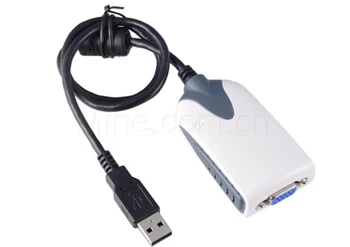
Usb Vga Display Adapter Driver Linux
I've been offered a Macbook Pro mid-2012. Although it wouldn't have been my first choice it's still a great piece of hardware, only problem for me is that it only has a single Thunderbolt port allowing me to plug only one external monitor by default. I use Debian 64-bit on it and I've been looking for solution to add a second external monitor (third total). My only option seems to be using a adapter. I'm aware of the limitations, it will be for basic coursework and office stuff. I've been Googling for a while and can't seem to find any reliable information on using these kind of devices on Linux.
DisplayLink USB 2.0 Graphics Adapters on Linux – 2014 Edition. Provided your main display adapter is a recent Intel chip. USB 2.0 HDMI/DVI/VGA Adapter for. Sep 20, 2017 - GAE2#dnlds), they propose only drivers for windows not for linux. Suitable data over USB to the USB2VGA so that it displays on a VGA.
I'm adventurous so I don't mind getting dirty in config files, although I don't have much experience with these things on Linux. Has anyone had any experience in getting these to work? Which device would you suggest? Any help/pointers/personal experiences.
NOTE: I'm not asking for information for the particular device linked, my question is mainly, does anyone have any experience in getting any USB to VGA device working on Linux and if so, which device? Perhaps a comment on the particular configurations used, as setting them up on Linux appears to be non-trivial. The UltraVideo device If you look at it doesn't support Linux. Features Support Windows XP,Vista, Winodws 7,Windows 8, windows 8.1, Mac OS up to 10.9.4 (**Does NOT support XP 64bit and Windows Server**) System Requirements Does NOT support XP 64bit and Windows Server/Linux Other compatible devices? Option #1 In general USB to (HDMI,DVI,VGA) devices either work or don't.
But there are devices that are known to work under Linux, such as this one: Option #2 As well as this one:. Does it work with Linux? An open source driver is available, for DL-1x5 devices which is now built into the Linux kernel. Linux support for DL-3x00 or DL-41xx is not currently available. Digging further with respect to the: The Linux kernel 3.4 also contains a DisplayLink driver, but current generation USB3 chips are not supported as of Sep 2014. It looks like no current DisplayLink-chip will ever work under Linux [17] due to intended encryption. Option #3 Here's another option:.
• Windows 8/7/XP drivers installed automatically via Windows Update (Internet connection required) • Mac is not supported due to significant limitations in the operating system. -Linux configuration for advanced users only The Pluggable website even has a page devoted to Linux, titled:. The article had this to say on the issue: Excerpt The short story Multi-monitor on Linux, especially with multiple graphics cards and USB graphics adapters, remains problematic. Skripsi sistem informasi perpustakaan berbasis web check in. You can find many distros and configurations where it just won’t work.
We’d recommend staying away unless you’re an advanced Linux user who is willing to play with different distros, install optional components and do hand configuration. Unfortunately, it’s just not plug and play yet today, as it is on Windows The long story That said, it is possible to get things working in limited scenarios for USB 2.0 generation DisplayLink-based adapters. We used all Plugable products in the tests for this post. Our test systems included Intel, Nvidia, and AMD primary graphics adapters. For Nvidia and AMD, we tested both the open-source and proprietary drivers. Intel is the most compatible, providing decent results under all configurations.
Nvidia graphics cards, when running the open source nouveau driver, only work in Multi-Seat mode. Attempting multi-monitor setup with a DisplayLink adapter and an Nvidia graphics card results in garbage graphics being displayed on your DisplayLink-attached monitor.
The Nvidia proprietary drivers do not work under any scenario. The AMD open-source drivers work under both multi-seat and multi-monitor setups, but the performance, at least in our tests, is significantly worse than with the Intel drivers.
The AMD proprietary drivers are unavailable in any easy to install package under Fedora 20, but we installed them in Ubuntu, and were unable to get any results, they simply do not work with DisplayLink graphics. TL;DR As I've shown, it isn't a simple answer, it's very hit or miss, which devices will work with which particular distros of Linux.